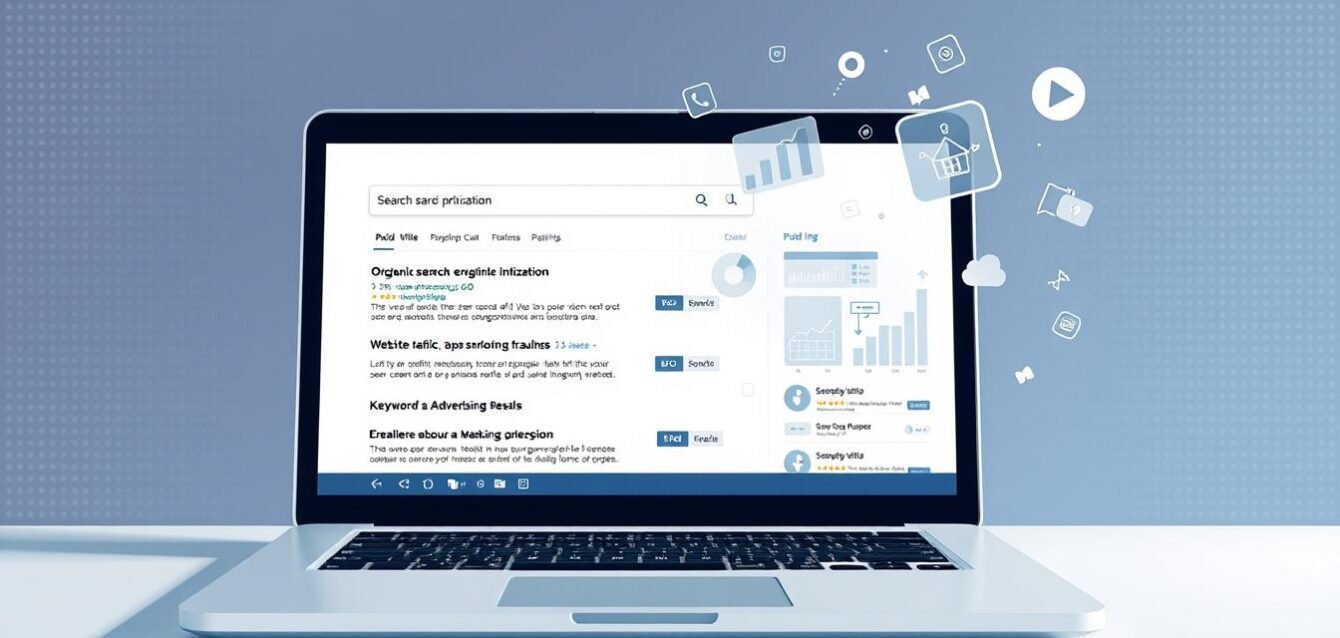Did you know that Amazon now averages 8-9 paid spots per search query? This highlights the growing competition for visibility on search engines. To stay ahead, businesses must combine SEO improvements with targeted paid advertising.
At Macro Webber, we specialize in Performance Marketing That Drives Revenue®. Our approach ensures your brand achieves maximum visibility and authority. With insights from trusted sources like Profitero, we’ve seen how ad spaces are becoming more competitive.
Why is this important? A strong marketing strategy requires both immediate results from paid campaigns and long-term growth through SEO. Together, they create a powerful way to reach your audience and drive conversions.
In this guide, you’ll learn practical, data-driven strategies to optimize your efforts. Whether you’re looking to boost traffic, improve rankings, or increase sales, combining these methods is key to success.
Key Takeaways
- Combining SEO and paid advertising maximizes visibility and authority.
- Paid campaigns provide immediate results, while SEO offers long-term benefits.
- Data-driven strategies help optimize your marketing efforts.
- Competition for ad spaces is increasing, making a balanced approach essential.
- Macro Webber’s expertise ensures your campaigns drive revenue effectively.
Understanding the Basics of Paid and Organic Search
Understanding the differences between paid and organic efforts is crucial. Both play unique roles in driving traffic and achieving marketing goals. While paid search offers immediate visibility, organic search builds long-term authority. Together, they create a powerful strategy for your business.

Defining Paid Search and Its Role
Paid search, also known as pay-per-click (PPC), involves bidding for ad placements on search engine results pages. These ads appear at the top or bottom of the page, marked as sponsored. Platforms like Google Ads and Amazon use a cost-per-click (CPC) model, where you pay only when a user clicks your ad.
For example, Profitero data shows that Amazon averages 8-9 paid spots per query. This highlights the competitive nature of paid advertising. While it requires investment, paid search delivers quick results, making it ideal for short-term goals like product launches or promotions.
Exploring Organic Search and SEO Fundamentals
Organic search relies on SEO to improve your website’s visibility. This involves optimizing content, using relevant keywords, and enhancing user experience. Unlike paid search, organic results are free but take time to build.
Studies show that SEO can increase organic traffic by 43% year-over-year. It’s a long-term investment that drives sustainable growth. However, it requires ongoing effort to stay ahead of competitors and adapt to search engine algorithm changes.
Both strategies have their pros and cons. Paid search offers immediate results but can be costly. Organic search is cost-effective but requires patience. At Macro Webber, we help you find the right balance to maximize your marketing success.
Balancing Organic Search and Paid Ads in Your Distribution Strategy
Maximizing your online presence requires a strategic blend of immediate and long-term efforts. Combining paid and organic methods ensures your business stays competitive and visible. This approach not only boosts traffic but also enhances your brand’s authority over time.

Leveraging Profitero Insights for Competitive Visibility
Profitero’s data reveals that brands achieving top organic placements see up to 4x more sales. This highlights the importance of integrating SEO with paid efforts. By analyzing market share and pricing trends, you can identify opportunities to outpace competitors.
For example, Walmart’s tripled ad real estate shows the growing competition for visibility. Using these insights, you can adjust your campaign to focus on high-converting products and optimize ad spend.
Data-Driven Strategies to Optimize Your Campaign
Practical strategies can help you achieve better results. Start by analyzing keyword performance to align paid and organic efforts. This ensures your content ranks higher while reducing wasted investment.
- Use data to identify high-traffic, low-conversion areas and improve content quality.
- Focus on promotional campaigns that drive both immediate sales and long-term growth.
- Regularly test and measure your campaign to stay responsive to market trends.
At Macro Webber, we specialize in creating Performance Marketing That Drives Revenue®. Our team helps you integrate these strategies for maximum impact. Contact us today to elevate your marketing efforts.
Optimizing Content and Campaigns for Maximum Impact
To achieve maximum impact, your campaigns and content must work together seamlessly. By focusing on quality and leveraging data, you can enhance visibility and drive better results. This section explores actionable steps to refine your approach and achieve your goals.

Enhancing Content Quality and Relevance
High-quality content is the backbone of any successful marketing effort. It not only improves search rankings but also boosts conversion rates. Start by refining your website images, videos, and product descriptions to create a compelling user experience.
For example, adding A+ content to your product pages can increase engagement by up to 40%. This type of optimization ensures your brand stands out and resonates with your audience. At Macro Webber, we specialize in crafting content that drives both immediate and long-term results.
Utilizing Keyword and Ad Data for Strategic Adjustments
Data is your most valuable resource when optimizing campaigns. Analyze keyword performance to identify high-traffic areas and align your content accordingly. This approach reduces wasted investment and maximizes ROI.
- Use data to refine your campaign focus and target high-converting products.
- Regularly test and measure results to stay responsive to market trends.
- Integrate insights from paid and organic efforts to create a cohesive strategy.
By making strategic adjustments based on clear insights, you can streamline your efforts and achieve better outcomes. At Macro Webber, we help you turn data into actionable steps for success.
Integrating SEO Techniques with Paid Media Efforts
Combining SEO and paid media efforts can significantly boost your online presence. This integrated approach ensures your brand dominates search results while maximizing visibility and authority. By aligning both strategies, you can achieve immediate results and long-term growth.

Developing a Unified Keyword Strategy
A unified keyword strategy is essential for success. By analyzing data from both SEO and paid campaigns, you can identify high-performing terms. This approach ensures your content ranks higher while reducing wasted investment.
For example, using insights from paid campaigns can reveal which keywords drive the most traffic and conversions. These terms can then be optimized for organic search, creating a seamless user experience.
Collaborative Analytics and Performance Tracking
Tracking performance across both channels is crucial. Integrated analytics provide a comprehensive view of your campaign success. This data helps you make informed decisions and adjust strategies for better results.
Tools like Google Analytics and SEMrush allow you to monitor traffic, conversion rates, and keyword performance. By aligning metrics, you can refine your approach and achieve your marketing goals.
| Metric | SEO | Paid Media |
|---|---|---|
| Traffic | Long-term growth | Immediate results |
| Conversion Rate | Higher over time | Quick wins |
| Cost | Low | Higher |
At Macro Webber, we specialize in Performance Marketing That Drives Revenue®. Our team helps you integrate SEO and paid media efforts for maximum impact. Contact us today to elevate your marketing strategy.
Actionable Steps to Future-Proof Your Campaign
Future-proofing your campaigns requires a proactive approach to budgeting and performance tracking. By focusing on efficient resource allocation and continuous improvement, you can stay ahead in a competitive digital landscape. Here’s how to ensure your efforts remain effective over time.

Effective Budgeting and Resource Allocation
Allocating your budget wisely is crucial for maximizing ROI. Start by analyzing your campaign performance to identify high-impact areas. Tools like Google Analytics can help you track traffic and conversion rates, ensuring your investment is directed toward the most effective channels.
For example, studies show that companies with aligned SEO and PPC teams reduce duplicated efforts and inflated budgets. By integrating these strategies, you can optimize your marketing spend and achieve better results.
- Use data to prioritize high-converting keywords and pages.
- Adjust your advertising spend based on real-time performance insights.
- Allocate resources to both immediate wins and long-term growth initiatives.
Testing, Measuring, and Iterating Your Approach
Continuous testing and iteration are essential for staying relevant. Regularly evaluate your campaign performance using advanced analytics. This allows you to make data-driven adjustments and respond to changing market conditions.
For instance, Performance Max campaigns on Google optimize for conversions across multiple platforms. By leveraging these tools, you can enhance your brand’s visibility and drive better results.
| Metric | Importance | Action |
|---|---|---|
| Traffic | Measures audience reach | Focus on high-traffic keywords |
| Conversion Rate | Indicates campaign effectiveness | Optimize landing pages |
| Cost Per Acquisition | Evaluates budget efficiency | Adjust advertising spend |
At Macro Webber, we specialize in Performance Marketing That Drives Revenue®. Our team helps you implement these strategies to future-proof your business. Contact us today to elevate your marketing efforts.
Conclusion
To achieve lasting success, integrating PPC and SEO is essential. This guide has highlighted how combining these strategies maximizes visibility and drives measurable results. By leveraging data-driven insights, you can optimize your campaigns for both immediate and long-term benefits.
Consistent evaluation and strategic adjustments are key to staying ahead. Whether you’re aiming to boost traffic or enhance your brand’s authority, the synergy between PPC and SEO ensures sustained growth. Implement the actionable steps discussed to future-proof your marketing strategy.
At Macro Webber, we specialize in Performance Marketing That Drives Revenue®. Our expertise ensures your efforts deliver maximum impact. Contact us today at www.macrowebber.com to elevate your company’s success.



